A Sailor's Life
This fifth in a series of articles on the Memorial’s tattoo project and tattoo collections focuses on members of the Royal Australian Navy.
The Memorial’s Ink in the lines project is documenting the stories of servicemen and servicewomen through oral history interviews and portrait photography. The Memorial’s “tatt team” have been to Victoria, Queensland, and New South Wales, meeting some wonderful veterans who generously shared their time and their experiences. We are still receiving images and stories submitted via our online form. Here are some of the stories and images that have been shared so far.
"Remembering the Anzacs is pretty important" - Brent
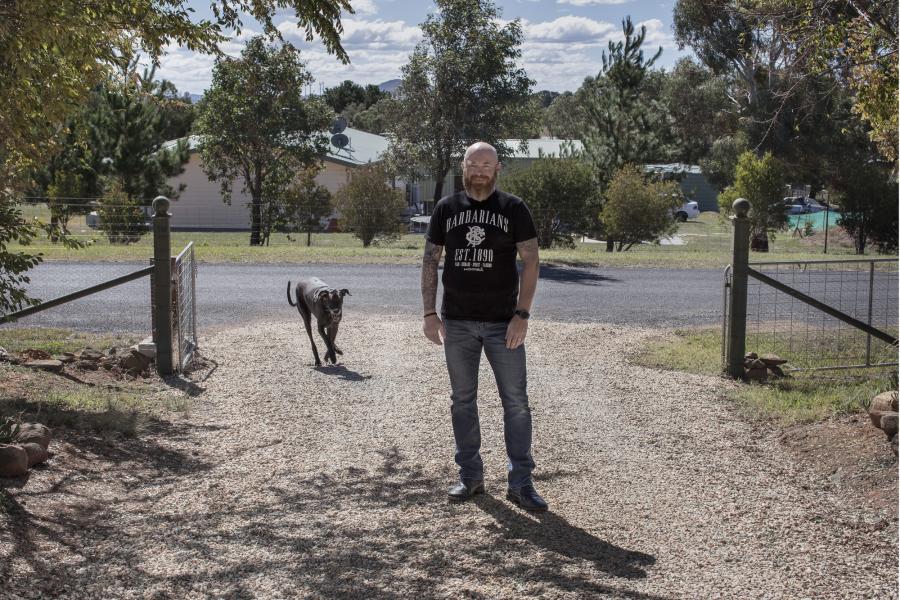
The Anzac tradition and remembering the Anzacs always been pretty important to me…
Brent joined the Navy as a seventeen year old, thinking to move on from the world of school and go travelling; he had an aptitude for Morse code and did well early on, but never thinking he’d stay with the Navy for thirty years. Time, and some world shaking events, changed his view:
My thinking in those days was that the Navy take me around the world and give me a good time. And I didn’t click till about nine years into my career that hang on, it’s the other way around. Things like the Gulf War came and it hit home to me. I’m here to do a job, not socialise around south East Asia.
Another defining moment was joining the crew of HMAS Brisbane, where, as Brent put it, his focus shifted from “having a good time to actually doing the job”. The role of the Brisbane in his own life was so important that Brent chose to represent it as a tattoo on his forearm.
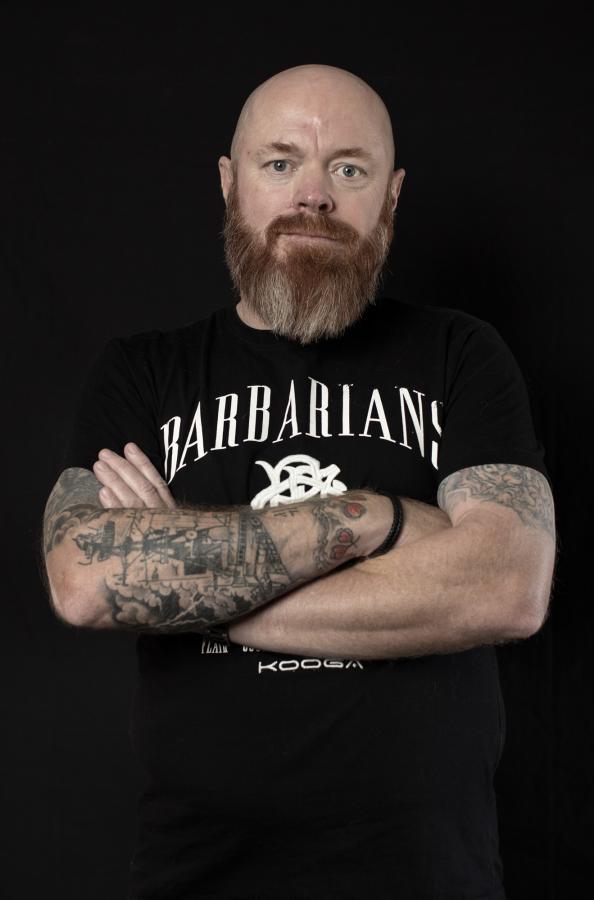
It was Brisbane that got me on track to do the job I was employed to do and really stepping up my work ethic -my level of professionalism improved out of sight, I went to being a high performing sailor. The ethic stays with me. Have a good time and all that but yeah the work very important.
Brent compromised a little with the design. To pay respect to HMAS Hobart, where he’d spent a lot of his time, the flags in his tattoo are the call sign for HMAS Hobart rather than for HMAS Brisbane.
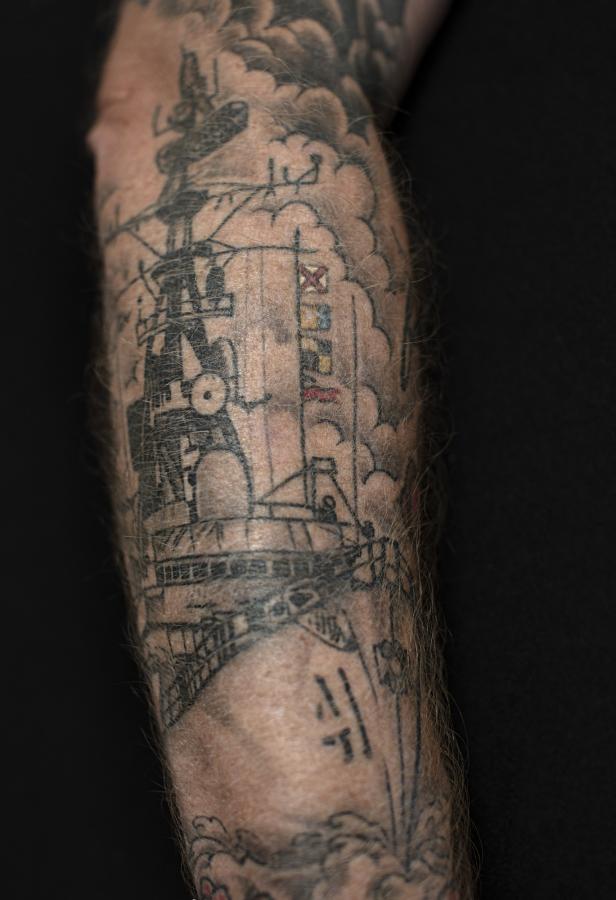
Brent got many tattoos as a younger sailor, and the change in theme and design since then reflects the personal growth he experienced in the Navy.
I used to have the old “needle with the blood group”, typical sailor tattoo. Most of my tattoos I got at Kings Cross.. The tattoos that I got in the late ‘80s, early ‘90s, there was no thought behind them.. These ones obviously meant a lot more to me, a lot more thought put into them and design.
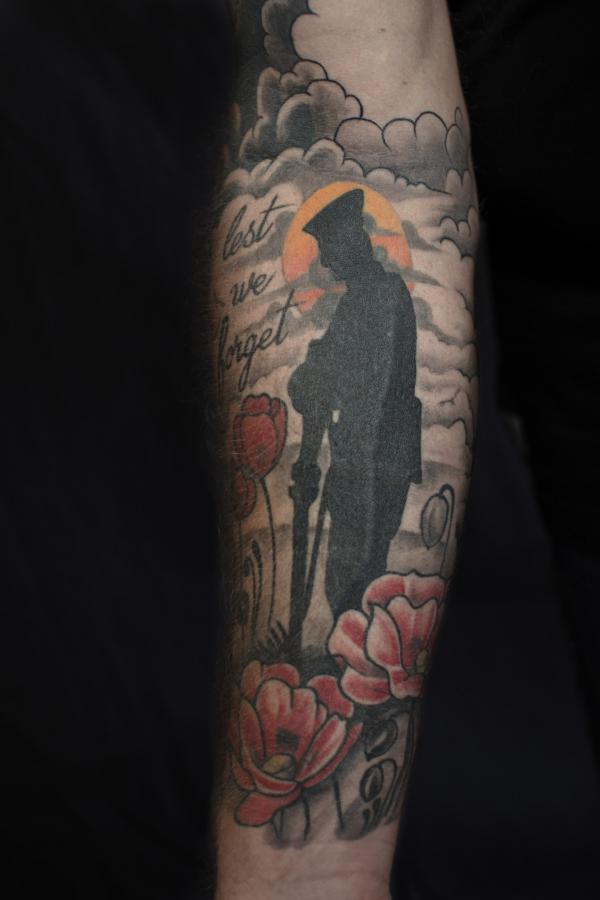
For his commemorative tattoo, Brent adapted a WW1 soldier to a WW1 sailor, standing in front of a tropical sunset to pay tribute to years serving in Darwin.
Every time look at them they just give you that little flutter of the heart .. remembering the fallen. And the navy ship that goes with it. They blended nicely into each other.. Every Anzac Day, I always look forward to catching up with old friends but also, remembering those who’ve been before us.
Brent was interviewed and photographed for the Memorial’s Ink in the Lines project, looking at tattoos in Australia’s military.
Chris - "If you had tattoos, you were a sailor"
Chris was in the Royal Australian Navy for over 20 years.
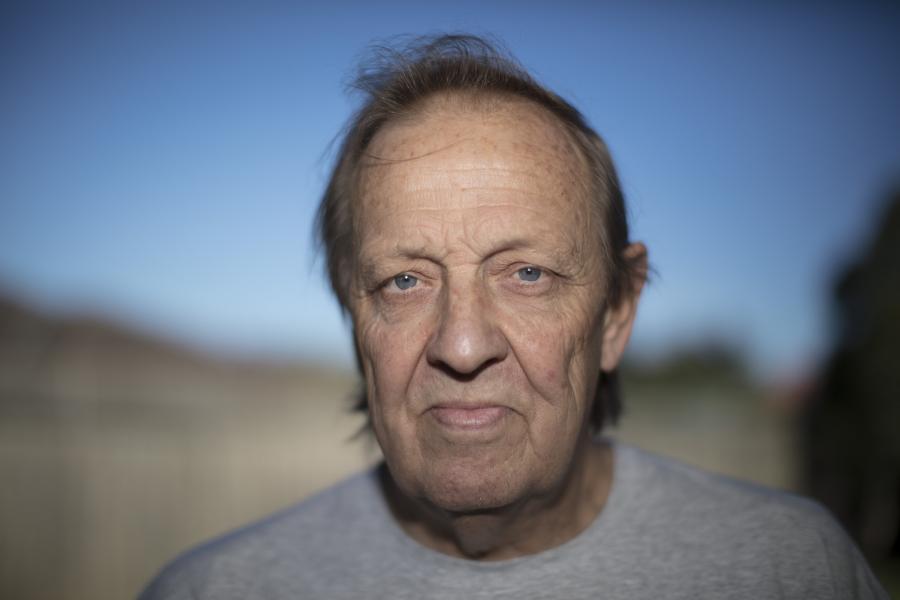
Back in the day, [if] you had tattoos, you were a sailor. And that’s how they identified you ... a lot of them would say, “now I’m a rough tough sailor”, but you’re not. Other guys went through Navy [for] 30 years, never got one.
Chris enlisted at an early age and initially he didn’t think he’d stay. The first night was more or less ok:
Things didn’t go right from the start.. On the way over some bozo set fire to one of the seats in the plane so his career didn’t start all that flash! But .. you’re like a fish out of water. .You go to a big hall where they give you something to eat. And it’s all easy and peasy and everyone’s so nice. Next day, it all changed - someone going round beating a bin and they’re teaching you to march.. Getting out there in uniforms and sitting down there in drill hall .. couple of guys are like, didn’t know how to wash, how to iron. You have to learn, cos if you get it wrong the whole class suffers. .. It was a quick learning curve, but it was great. I stayed and 26 years later, was still there.
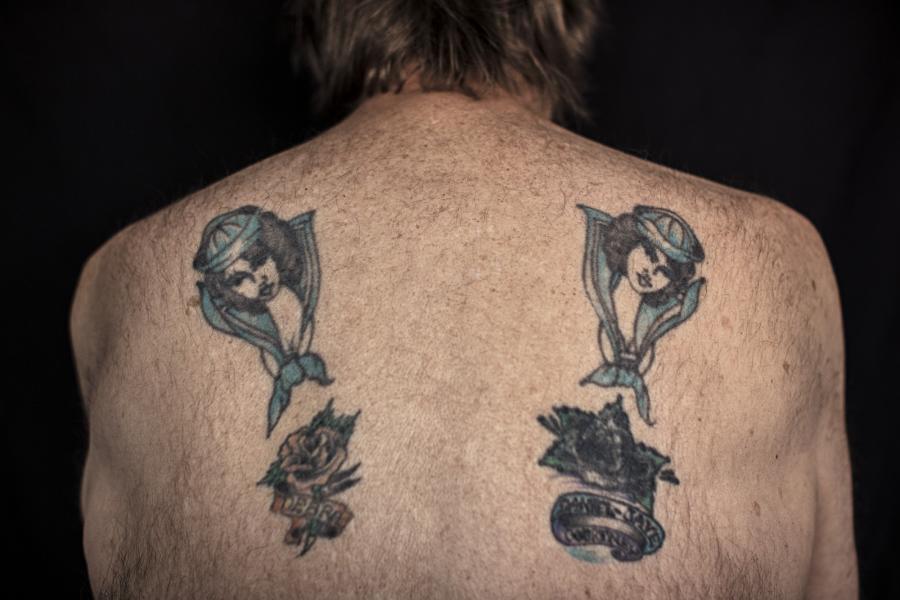
Chris has a tattoo in memory of his parents, and tattoos for his wife, Deb, whom he met while they were both in the Navy. He also has tattoos for their two children. Other tattoos, such as a pair of mermaids - one acquired in San Francisco, the other in Los Angeles - are like passport stamps for the places he’s been with the Navy. The mermaid on his right leg was originally designed to be part of a back piece; the tattooist he’d gone to didn’t have any mermaid templates and had to borrow a design from a neighboring studio.
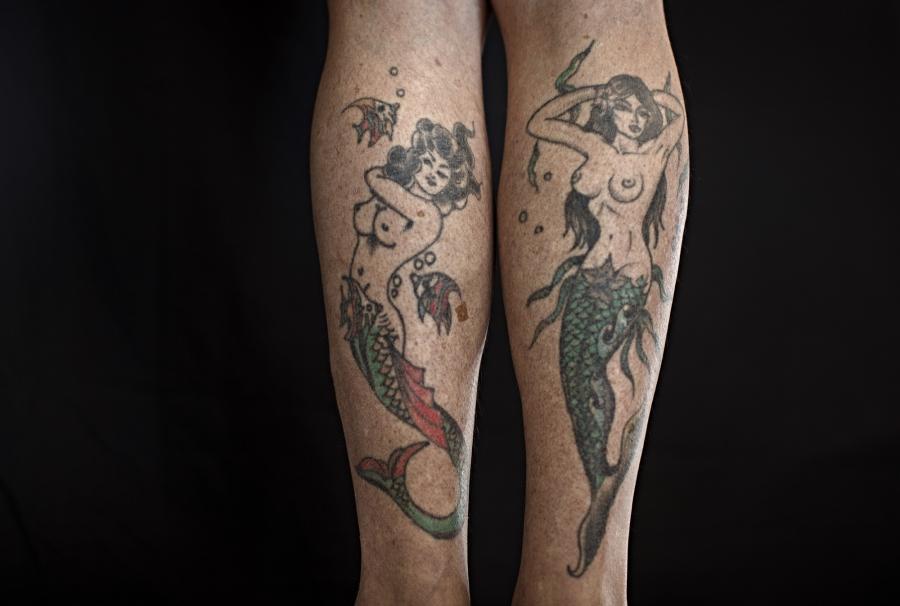
And why mermaids? Chris said,
A mermaid is to me, the sea.. A lot of blokes go with a ship tattoo, something like that but me, the mermaid is the sea.
Adrian, Submariner
Adrian is a currently serving member of the Royal Australian Navy who’s seen service aboard ships, submarines and even behind a desk. He said his mother still thinks he’s “crazy” to have become a submariner, but earning the submariners’ dolphin badge is something he’s very proud of.
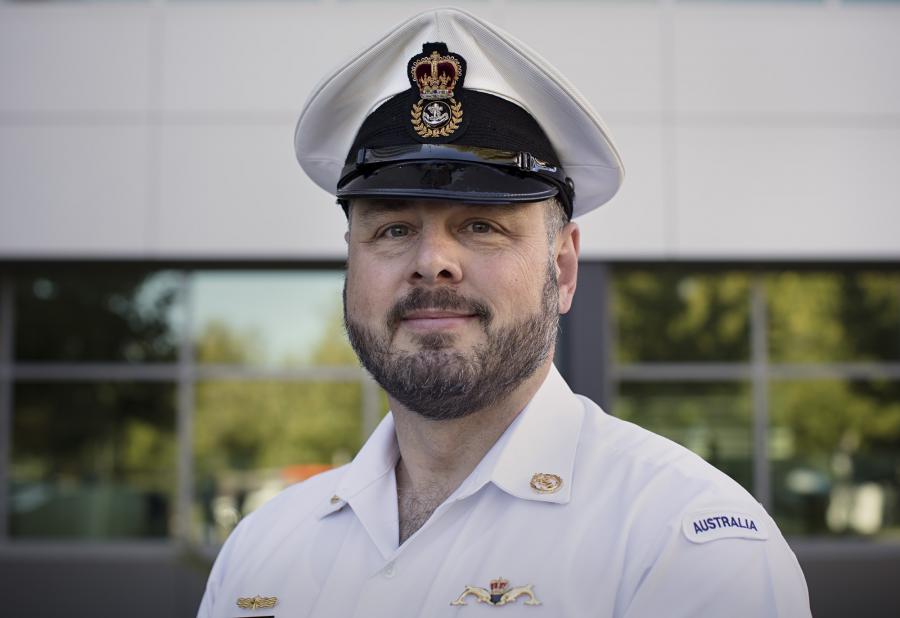
I think in submarines ..there’s an absolutely reliance on the sailor or officer, man or woman, who is sitting next to you or in that same confines, that they have the ability to do what’s required of them, almost instantly. .. And that was one of the defining moments for all of us, I think, that ‘I need to understand this machine or system intimately, because everyone else is doing that’. Though there’s still that aspect on ships. And the way its put is that everyone is in a very small club… earning the dolphin badge. And its very rewarding.
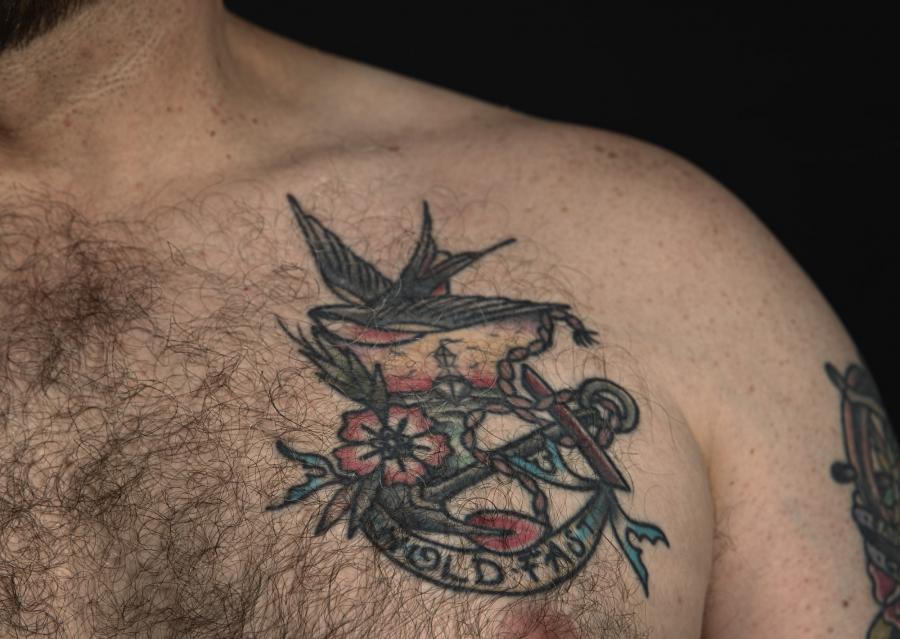
The dedication required to persist with qualification in this area of navy was part of Adrian’s motivation for his swallow tattoos.
The swallow tattoo, that I have sort of on my left breast and then the reverse on the left shoulder blade was ultimately borne out of the typical navy saying of ‘hold fast’. ..It was a piece of art that I thought represented what I am and where I was going, and again that hold fast of, you know, ‘carry on, and do the job ‘.. Also realising it can be can be damn hard work, physically and mentally.. And at the back, which, sort of I decided, I needed to put stuff behind me, and always walk away from it, and that’s why I got a tattoo of the symbol of a ship at sea in a dark and stormy sea, a ship in what we would call ‘the roughers’ , the saying of ‘let go’ – trying to move forward and leave stuff behind, by the same token. And it has that personal meaning too.
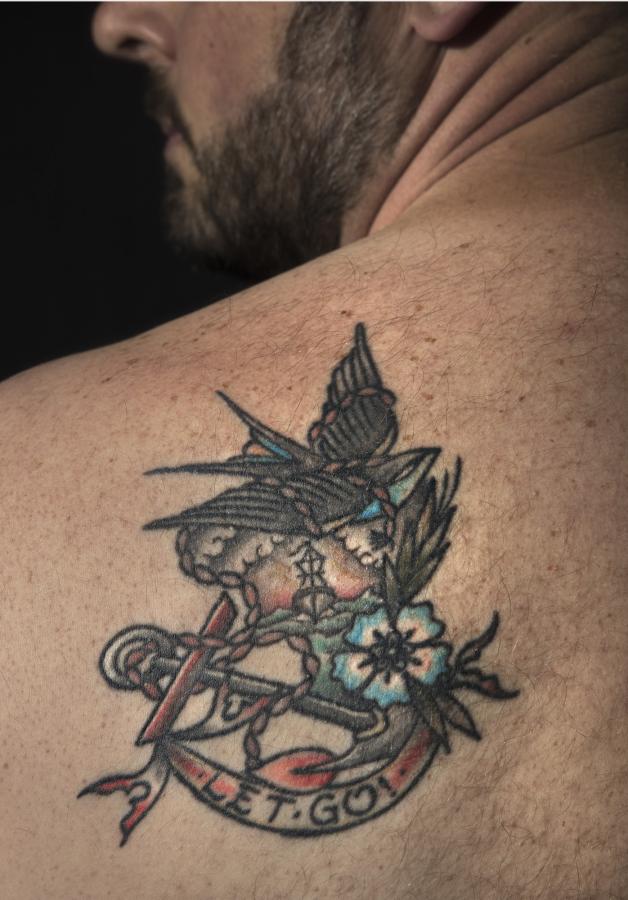
Adrian was interviewed and photographed for the Memorial’s Ink in the Lines project, looking at tattoos in Australia’s military.
Supporting veterans - Stephen
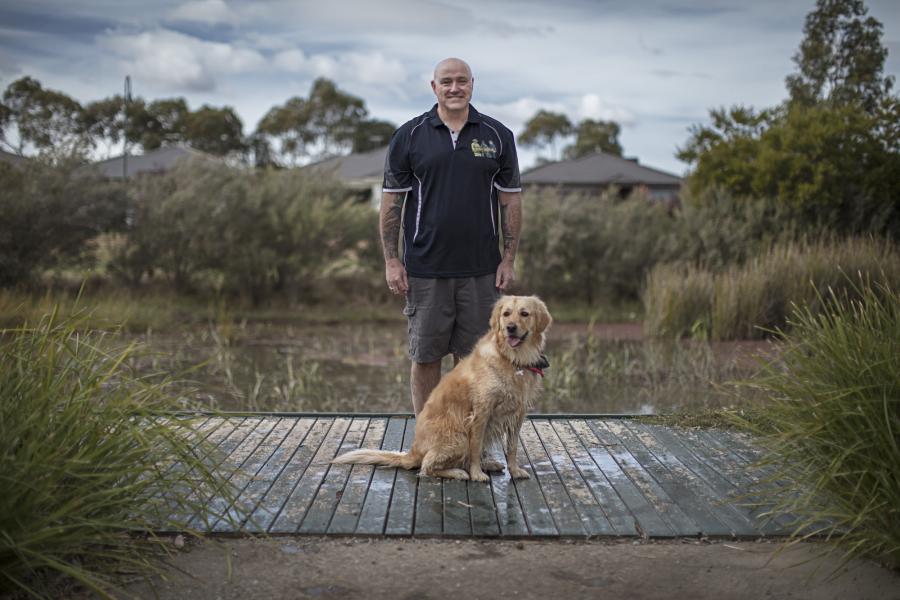
Family supported Stephen’s choice to enlist with the Royal Australian Navy at the age of 15. He remembers being “a typical teenager. Typical rebellious, not a bad person but typical, and then I had a lightbulb moment, needed to get my act together”. He trained as a ship’s boilermaker, doing welding and fabrication around the ship. He remembers that back in his day, there was “not a lot of OH&S”:
You’d be going up nearly vertical ladders. .On HMS Supply, we didn’t use block and tackle... part of all that toughening up and character building. Very dirty old ships, weren’t the shiny pieces of kit they’ve got these days!
The memory of particular ships has stayed with him. The refit of HMAS Swan was “hard yakka, dispelling any idea it was an easy life.”
You could see literally into the machinery decks cos they were cutting the decks and we were living on the ship as well, and that was hard yakka, it really was, 12, 14 hour days, turbines going, greasy, oily but it was fun. You learned a lot.
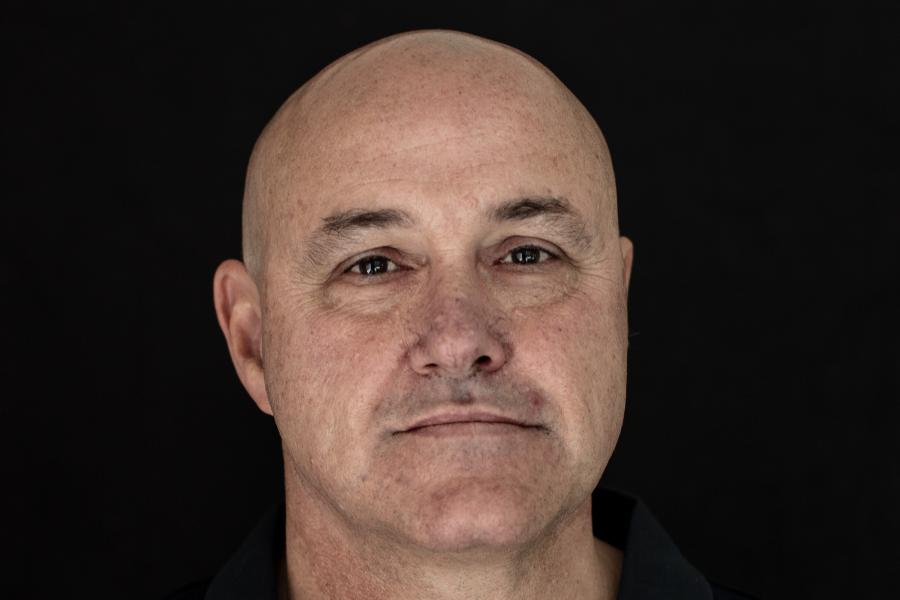
But his favourite posting, the best ship of all, was HMAS Stuart. It was the first ship which, for Stephen, “had a soul”. Stuart had the “best ship’s company ever”:
A very much a close community, great bosses, life- long friends – my third ship and by that time I knew what I was doing.. And there’s camaraderie through adversity. .Plus, it was a destroyer escort, that’s the best. ..a terrific ship. A good looking ship !
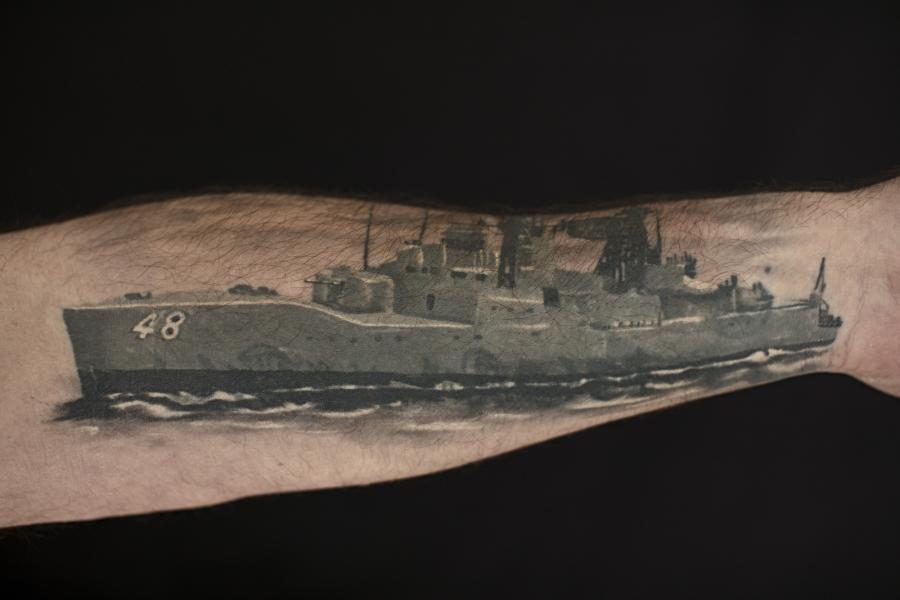
Stephen’s ongoing affection for HMAS Stuart is demonstrated by the tattoo of it, on his left arm. It’s so detailed that he can point out many of its real life features, even where the messes were; he can almost literally conduct a tour of his favourite ship, straight off his forearm.
Stephen credits the formation of his “strong moral values” to his naval service, values which helped him in his police career. Navy made my sense of who I am.. It was the building blocks of who I am.
Being former navy, and later a state policeman, gave Stephen insight into the post- traumatic stress experienced by military veterans. He works in the Young Veterans Network, supporting young veterans working through their PTSD or transition out of the forces.
All up I’ve done 23 years with Police Force and 10 years with Navy. I like doing it, I like helping people.. If at my funeral , one day, someone goes, ‘He gave 40 years of his life’. That’d be pretty cool. If you’ve done nothing in your life, at least you’ve served your country and you’ve served your community.
Stephen was interviewed and photographed for the Memorial’s Ink in the Lines project, looking at tattoos in Australia’s military.
"Talking is good" - Jamie
I was never into tattoos. And even like, when I first joined people said, ‘Oh, you’re going to get “tatt’d”. And I didn’t get tattooed for six years.. Till right up to the day I was in the Cross with a mate and I said, ‘I want a tatt’.
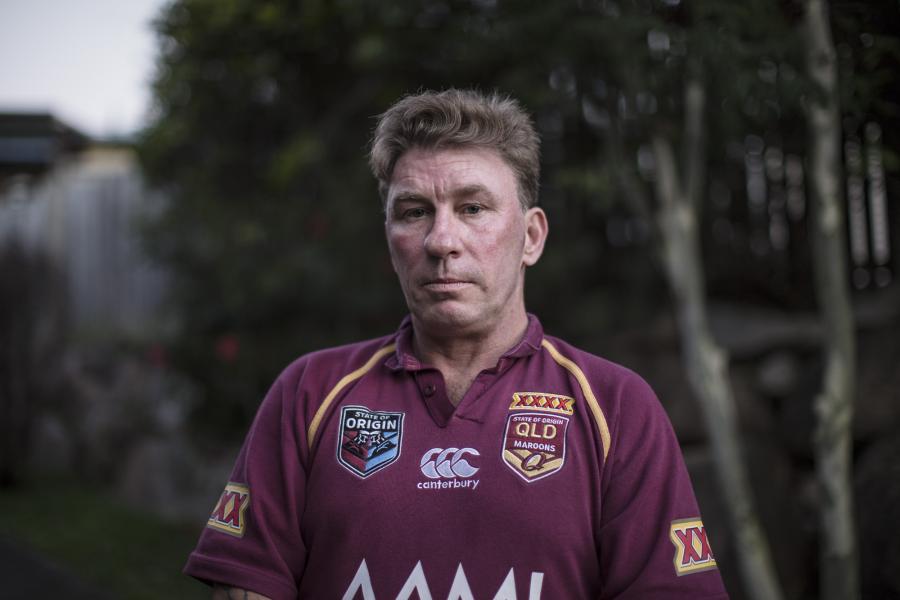
Jamie had always wanted to join the Navy, but life turned him in other directions and he didn’t enlist until his twenties. Initially trained as a combat systems operator (sonar), he was deployed the Arabian Gulf to do help in anti-piracy work and defence of oil rigs during the Second Gulf War.
Jamie‘s no longer in the Navy, but still misses it.
Loved being at sea… Loved what I did, loved the people I worked with, captains, commanders. It’s a big difference, a culture shock, to come out.. and hard.
Jamie’s tattoos are reminders of places he’s been, ships he served with, and happy as well as harder memories. It just become addictive and I just think it’s a good way to remember what I’ve done.

I think the anchor up here was my very first one, for navy - I guess I got it to remind me of the navy. .That everything’s still strong and all that. From there I just built on, [getting] something for all of I’ve done.
My devil, he was the mascot for HMAS Melbourne, that I went to Iraq on. It was done by an apprentice tattooist, ex -Army - and back here, the shellback turtle. Whenever a sailor crosses the equator we have that tradition of crossing, I’m sure you’ve heard of, basically you say to King Neptune, ‘We’re crossing’, he lets you into his realm. It’s just another way of saying you’ve crossed the equator.
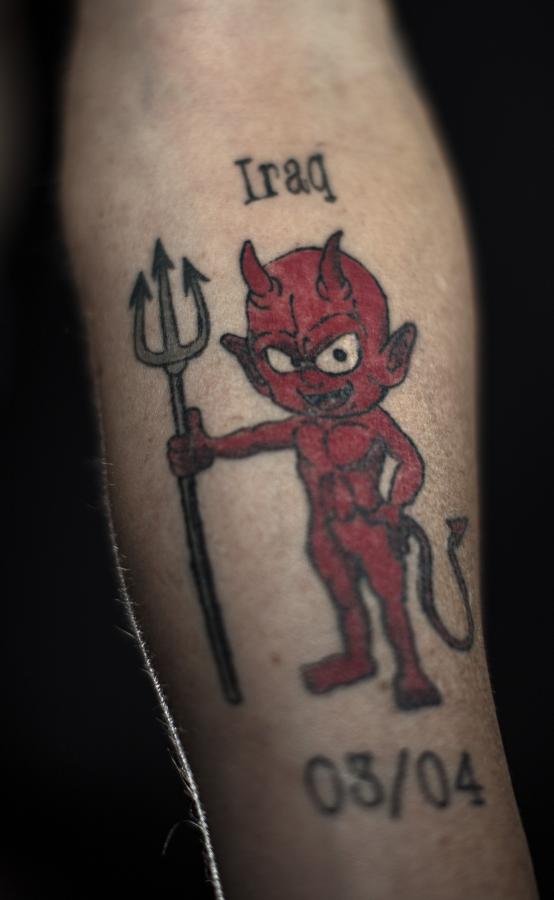
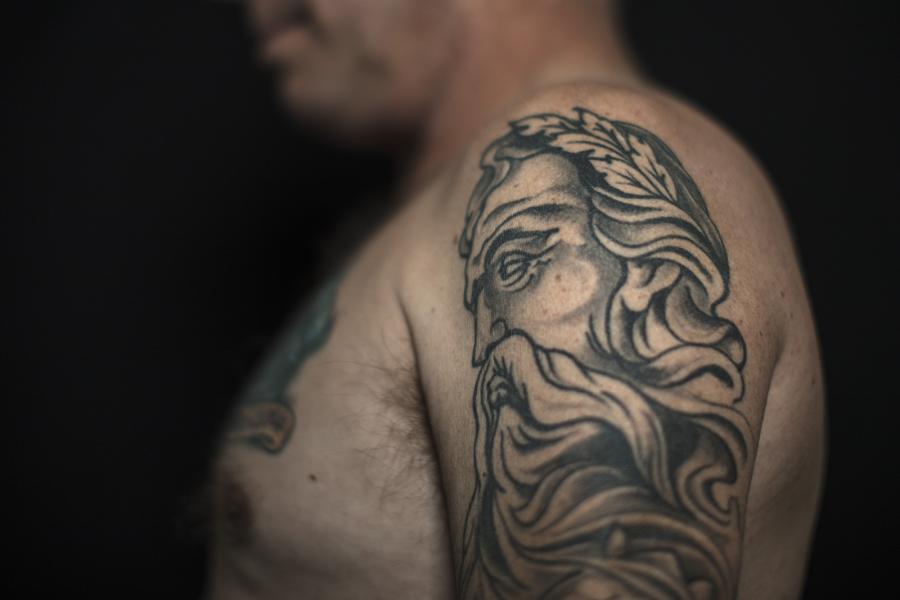
The striking gold bird tattoo is of a “golden bosun”, a bird which represents a trip to Christmas Island and service for border patrol:
That’s what type of bird is up there, you just see it prolifically out there and its heaven. They’re a beautiful bird and that’s all we saw for months. They’re like seagulls here.. hard to think of a tattoo that ties to things like that. The golden bosun was the easiest thing for something like that and the border protection roles that I did.
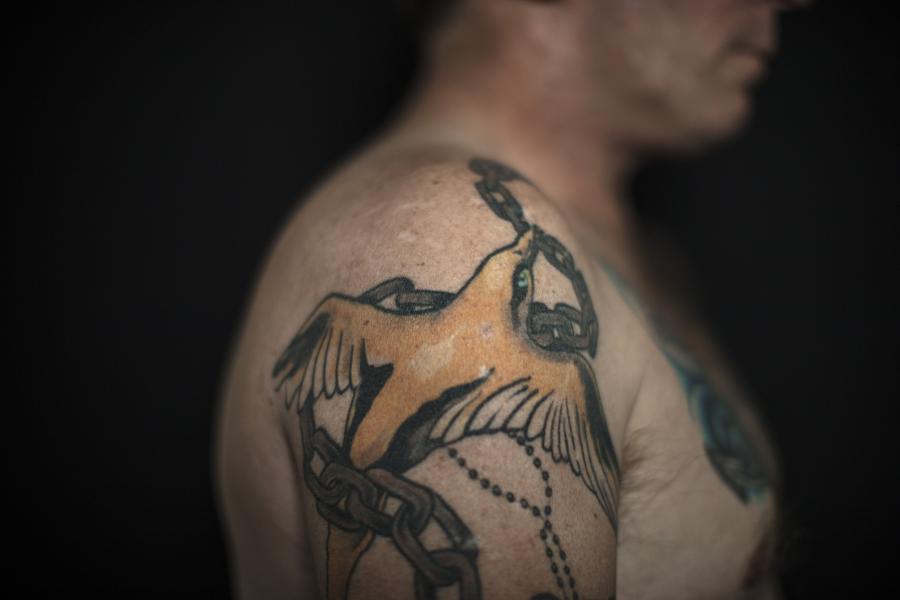
Jamie enjoys the fact that the tattoos act as a conversation piece, and the placement of the tattoo is as important for him as the things they represent. He’ll never get one on his back:
I want to be able to look at them. .I love looking back on my time in the Navy.. Sure there were some bad times but they were few and far between of those, so, and talking about them brings up good memories, and makes you feel good.
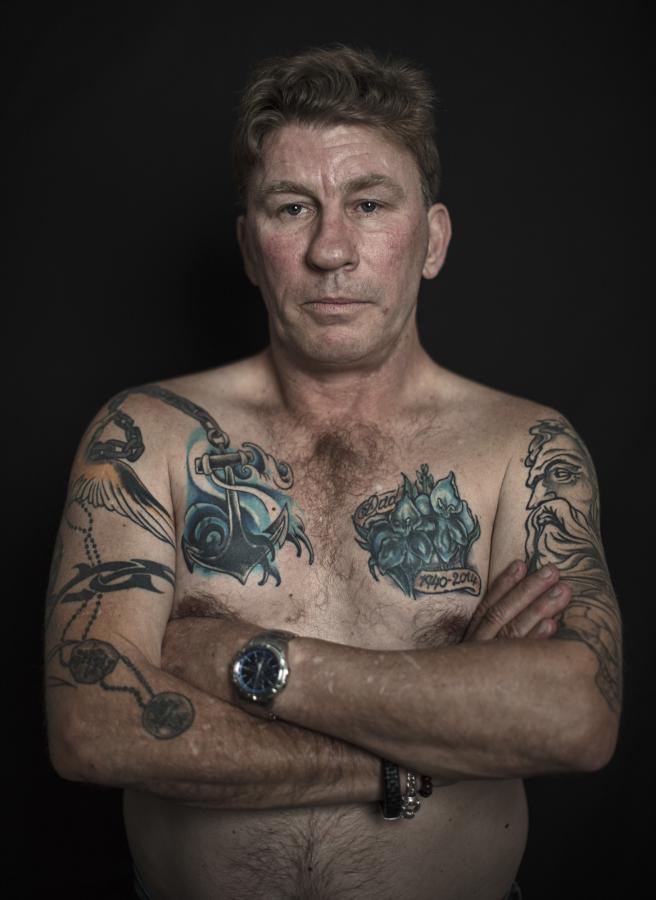
And he has advice for others about tattoos:
My friend’s son just joined the Navy last week and I said to her, chances are he’ll get a tattoo, yeah that’s ok. A tattoo is a personal choice.. It doesn’t mean you’re a bad person. It’s not the old bikie thing or prison thing and there’s lot of women with tattoo, and it’s an art form. There are some amazing artists out there. There’s a lot of tattoos out there and they’re educating people.. That’s why I’ve chosen to do this.
Jamie was interviewed and photographed for the Memorial’s Ink in the Lines project, looking at tattoos in Australia’s military.
Bones – Veteran & Tattooist
Peter “Bones” Bone was always interested in drawing, and although his first career was in the Navy, first as a Bosun’s mate and later as Coxswain, he continued to develop his drawing skills and learned how to tattoo along the way. After leaving the Navy, his talents were sought after by other veterans.
As a naval police coxswain, (NPC), Bones was probably not what most people would think of as a natural tattooist, but naval experiences gave him a toolkit of organisational skills which complement his artistic ones.
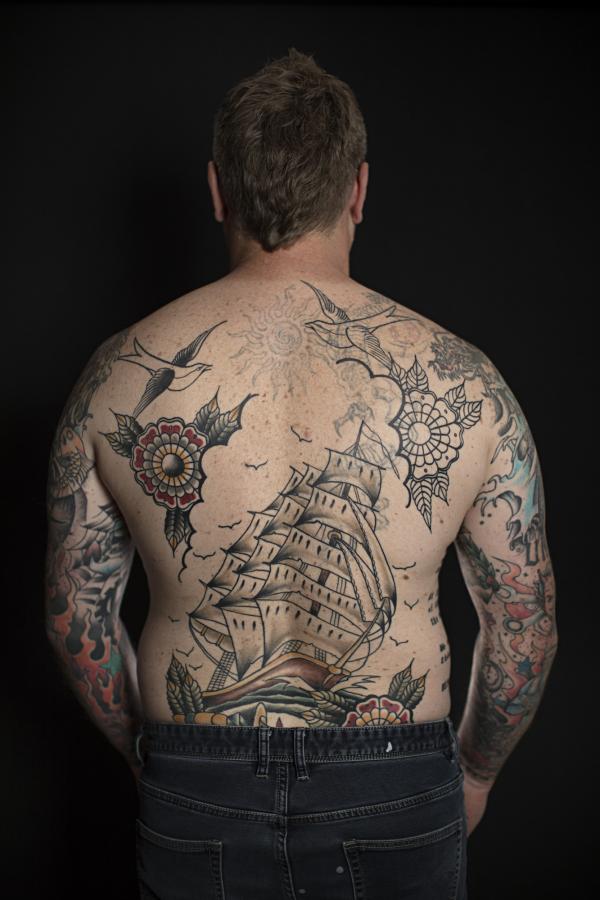
Bones favours the “Sailor Jerry” style of tattoo; as he says it is “the epitome of being an old salty sailor”. Still identifying as a sailor himself, Bones’ own tattoos are a clear demonstration of his personal history:
My chest piece is really, I suppose, my interpretation of a ‘Jolly Roger’.. it’s got swallows through the side, referring to nautical miles that’s been sailed. Pretty much any area in my life that’s been influenced.. has some sort of reference to it… Under my arms I’ve got more nautical style of things that are very influenced by Sailor Jerry - again, anchors, sailors, skulls, things like that. I just try to express myself thru my tattoos, with my nautical background.
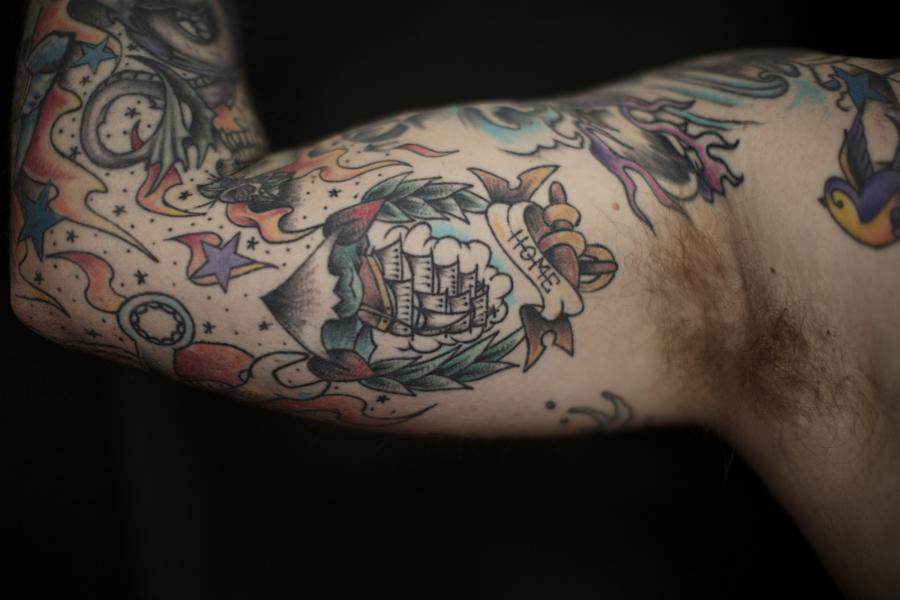
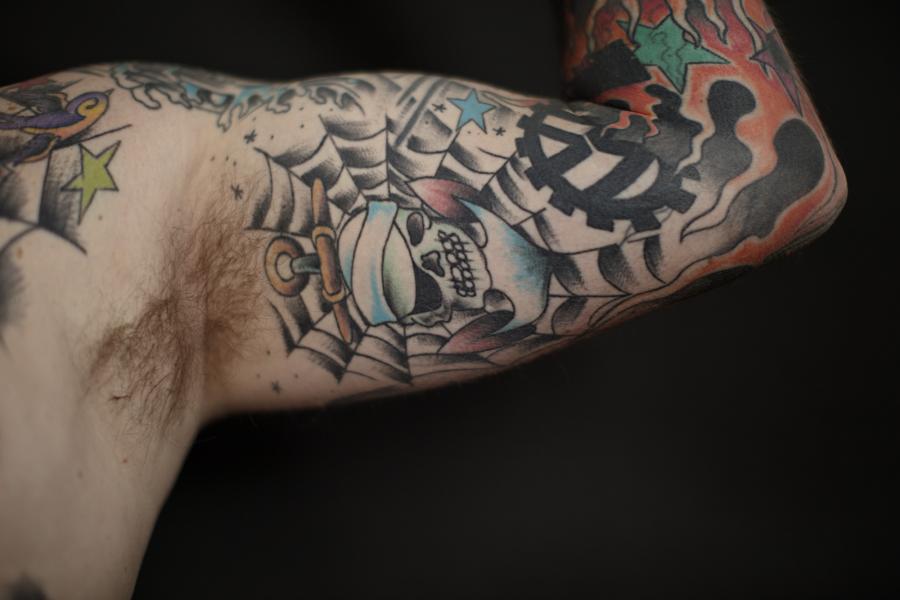
Bones’ background is also helpful when meeting fellow naval veterans:
..For sailor tattooing, it’s quite humbling.. When it’s military orientated, cos they simply feel more comfortable, particularly if they’re suffering from PTSD or the effects of their service, they find that they can just sit here, be themselves, they know I’ve had similar background, similar experiences – they can vent if they need to. .You’d be surprised what people say in the first 15 minutes.
A lot of tattooists don’t realise the actual direct affect it can have on someone’s life.
Peter Bone was interviewed and photographed for the Memorial’s Ink in the Lines project, looking at tattoos in Australia’s military.